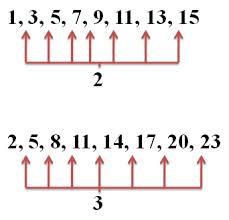AS sequence
In an arithmetic sequence is given the difference d = -3 and a71 = 455.
a) Determine the value of a62
b) Determine the sum of 71 members.
a) Determine the value of a62
b) Determine the sum of 71 members.
Correct answer:

You need to know the following knowledge to solve this word math problem:
Related math problems and questions:
- Geometric sequence 4
 It is given geometric sequence a3 = 7 and a12 = 3. Calculate s23 (= sum of the first 23 members of the sequence).
It is given geometric sequence a3 = 7 and a12 = 3. Calculate s23 (= sum of the first 23 members of the sequence). - Five element
 The geometric sequence is given by quotient q = 1/2 and the sum of the first six members S6 = 63. Find the fifth element a5.
The geometric sequence is given by quotient q = 1/2 and the sum of the first six members S6 = 63. Find the fifth element a5. - GP - three members
 The second and third of a geometric progression are 24 and 12(c+1), respectively, given that the sum of the first three terms of progression is 76. determine the value of c.
The second and third of a geometric progression are 24 and 12(c+1), respectively, given that the sum of the first three terms of progression is 76. determine the value of c. - Members
 A geometric sequence with six members has the sum of all six members equal to 63; the sum of the even members (that has an even index) has a value of 42. Find these members.
A geometric sequence with six members has the sum of all six members equal to 63; the sum of the even members (that has an even index) has a value of 42. Find these members.
- Fifth member
 Determine the fifth member of the arithmetic progression if the sum of the second and fifth members equals 73 and the difference d = 7.
Determine the fifth member of the arithmetic progression if the sum of the second and fifth members equals 73 and the difference d = 7. - Determine 2938
 Determine the first 11 members of the sequence if a12 = 676, d = 29.
Determine the first 11 members of the sequence if a12 = 676, d = 29. - Difference 61133
 Determine the difference of the arithmetic sequence (an), if given: a1 = 5, an = 23, Sn = 392
Determine the difference of the arithmetic sequence (an), if given: a1 = 5, an = 23, Sn = 392 - In the
 In the arithmetic sequence, a1 = 4.8, d = 0.4. How many consecutive members, starting with the first, need to be added so that the sum is greater than 170?
In the arithmetic sequence, a1 = 4.8, d = 0.4. How many consecutive members, starting with the first, need to be added so that the sum is greater than 170? - Remainders
 It is given a set of numbers { 117; 136; 363; 419; 575; 651 }. Divide these numbers by number 58 and determine a set of remainders. As a result, write the sum of these remainders.
It is given a set of numbers { 117; 136; 363; 419; 575; 651 }. Divide these numbers by number 58 and determine a set of remainders. As a result, write the sum of these remainders.
- The sum
 The sum of the first ten members of the arithmetic sequence is 120. What will be the sum if the difference is reduced by 2?
The sum of the first ten members of the arithmetic sequence is 120. What will be the sum if the difference is reduced by 2? - Corresponding 33321
 The following data on the height and the corresponding number of pupils were found in the measurement of 63 pupils: 159cm-1,161cm-1,162cm-2,163cm-1,164cm-2,165cm-2,166cm-3,167cm-2,167cm-3 6,172cm-7,173cm-9,174cm -5,175cm-2,177cm-1,178cm-4,179cm-2,181cm-1,
The following data on the height and the corresponding number of pupils were found in the measurement of 63 pupils: 159cm-1,161cm-1,162cm-2,163cm-1,164cm-2,165cm-2,166cm-3,167cm-2,167cm-3 6,172cm-7,173cm-9,174cm -5,175cm-2,177cm-1,178cm-4,179cm-2,181cm-1, - Determine 2937
 Determine the first 14 members of the sequence if a15 = 225, d = -12
Determine the first 14 members of the sequence if a15 = 225, d = -12 - Sequence 3
 Write the first 5 members of an arithmetic sequence: a4=-35, a11=-105.
Write the first 5 members of an arithmetic sequence: a4=-35, a11=-105. - AP members
 Insert as many arithmetic sequence members between numbers 1 and 53 that the sum is 702.
Insert as many arithmetic sequence members between numbers 1 and 53 that the sum is 702.
- Consecutive 69904
 The three numbers that make three consecutive members of an arithmetic sequence have a sum of 60 and a product of 7500. Find these numbers.
The three numbers that make three consecutive members of an arithmetic sequence have a sum of 60 and a product of 7500. Find these numbers. - Determine 2840
 Determine the first twelve members of the sequence if a13 = 95, d = 17
Determine the first twelve members of the sequence if a13 = 95, d = 17 - Five members
 Write the first five members of the geometric sequence and determine whether it is increasing or decreasing: a1 = 3 q = -2
Write the first five members of the geometric sequence and determine whether it is increasing or decreasing: a1 = 3 q = -2
